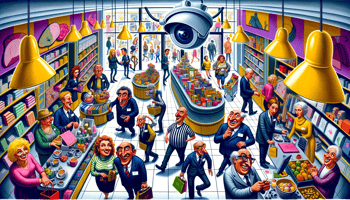Retailers today face a growing challenge: how to prevent theft while still delivering a positive,...
From Boardroom to Shopfloor: Bridging the Leadership Gap in CX

In retail, there’s often a familiar phrase whispered among frontline colleagues: “They don’t have a clue what it’s really like down here.” It’s not usually malicious, but it’s revealing. The gap between the boardroom and the shopfloor is one of the greatest risks to delivering excellent customer experience.
Why? Because customer loyalty is forged (or lost) in the daily interactions between your colleagues and your customers, not in the glossy slides of a board presentation.
The truth is, even the best strategies and most sophisticated data mean very little if leaders don’t understand and act on what’s happening at the coalface of their business.
The “translation gap”
Think of strategy like a language. The boardroom speaks in KPIs, EBITDA, and NPS. The shopfloor talks in “the card machine’s not working again” or “we ran out of bags during the Saturday rush”.
The issue arises when the language used in the boardroom isn’t translated into meaningful behaviours and priorities for colleagues. This “translation gap” means leaders might believe they’ve set a clear CX direction, while those implementing it face entirely different realities.
Take one high-street fashion chain we worked with. The leadership team proudly announced a new “digital-first customer journey” strategy, but store colleagues didn’t even have working WiFi. Customers who wanted to use the brand’s app instore found it unusable. The strategy was correct, but real-life experience rendered it irrelevant.
The reality check: walking the floor
Leaders often underestimate the impact that visibility can have. When a senior executive arrives on a Saturday afternoon, not for a staged “walk-through” but to get involved at the tills or stock shelves, colleagues notice. It demonstrates humility, curiosity, and respect.
One grocery retailer embedded this in their leadership culture. Executives had to spend one day each quarter on the shopfloor, not in a suit with a clipboard, but in a uniform, shoulder-to-shoulder with colleagues. The result? Significantly fewer “head office versus stores” complaints, and a leadership team that made more practical decisions because they genuinely understood the customer and colleague pain points.
It’s not rocket science; it’s empathy in practice.
When the boardroom listens, the shopfloor speaks up
Too many leaders underestimate the valuable insights that are quietly available within their teams. Colleagues often know which products customers request, which promotions fail to perform, and which processes are frustratingly inefficient.
But here’s the catch: if colleagues believe “nobody up there listens,” they stop speaking out. And when feedback loops shut down, leaders are flying blind.
Contrast that with a homewares retailer that introduced a “shopfloor to boardroom” programme. Every store manager could submit one CX improvement idea each quarter, and the board committed to reviewing them personally. Several ideas, from reorganising checkout layouts to adjusting stock pack sizes, saved the business millions while improving customer experience.
It worked because the board didn’t just ask for input; they acted on it.
Three practical steps to close the gap
- Create structured listening channels.
Don’t rely solely on occasional store visits. Establish regular feedback mechanisms where store colleagues see their ideas lead to meaningful action. Whether it’s quarterly listening groups or digital suggestion channels, the important part is visible follow-through. - Make leadership presence natural, not performative.
Replace the “CEO visit” with a consistent rhythm of genuine leadership visibility. Encourage directors and senior managers to spend time on the shopfloor, especially during busy periods. Equip them to ask questions, listen actively, and avoid rushing in with snap judgments. - Translate strategy into frontline relevance.
When launching a new CX initiative, ensure the language resonates with the shop floor. For example, “improving customer conversion” may mean very little to a sales assistant, but “helping more customers leave happy with what they came in for” makes sense.
Alternative perspectives
Of course, some leaders resist this. “We can’t run the business from the shopfloor,” they say. True. However, you also can’t run it without the shop floor.
Others argue that “digital dashboards” and “AI-powered insights” are enough. But anyone who has worked a Saturday shift at the tills knows that no dashboard captures the look on a customer’s face when they abandon their basket.
Bridging the gap isn’t about abandoning data or strategy. It’s about complementing them with lived reality. The best leaders use both.
Conclusion: the till doesn’t lie
At RetailCX, we often say: “Happy employees create happy customers who put money in the till.” And the till, after all, is where strategy becomes reality.
The true test of leadership isn’t just in shareholder updates or quarterly results, it’s in whether your colleagues on the shopfloor feel heard, supported, and equipped to serve customers.
From the boardroom to the shopfloor, the connection isn’t optional. It’s the only way to make sure that what leaders plan is what customers encounter.
Practical Summary / Action Plan for Leaders
- Spend time on the floor – not as a guest, but as a colleague.
- Establish genuine feedback loops – and demonstrate their effectiveness by acting on them.
- Translate the strategy into plain language – colleagues need to understand what it means for them today.
- Balance dashboards with reality checks – rely on data, but value real experience.
- Model humility and curiosity – the behaviours you demonstrate influence the entire organisation.
Bridging the boardroom-shopfloor gap isn’t glamorous, but it’s transformative. Get it right, and your strategy stops being a memo and starts being a movement.
At RetailCX, we specialise in helping organisations harness the power of leadership and employee engagement to enhance customer experiences. Contact us to learn how we can support your journey toward a more innovative and customer-centric future.




